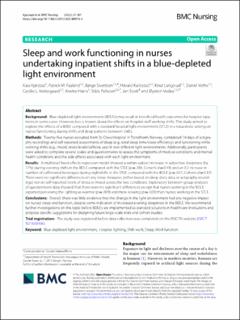| dc.contributor.author | Kjørstad, Kaia | |
| dc.contributor.author | Faaland, Patrick | |
| dc.contributor.author | Sivertsen, Børge | |
| dc.contributor.author | Kallestad, Håvard | |
| dc.contributor.author | Langsrud, Knut | |
| dc.contributor.author | Vethe, Daniel | |
| dc.contributor.author | Vestergaard, Cecilie Lund | |
| dc.contributor.author | Harris, Anette Kristoffersen | |
| dc.contributor.author | Pallesen, Ståle | |
| dc.contributor.author | Scott, Jan | |
| dc.contributor.author | Vedaa, Øystein | |
| dc.date.accessioned | 2022-10-03T11:11:22Z | |
| dc.date.available | 2022-10-03T11:11:22Z | |
| dc.date.created | 2022-08-17T13:56:19Z | |
| dc.date.issued | 2022-07-18 | |
| dc.identifier.issn | 1472-6955 | |
| dc.identifier.uri | https://hdl.handle.net/11250/3023325 | |
| dc.description.abstract | Background: Blue-depleted light environments (BDLEs) may result in beneficial health outcomes for hospital inpatients in some cases. However, less is known about the effects on hospital staff working shifts. This study aimed to explore the effects of a BDLE compared with a standard hospital light environment (STLE) in a naturalistic setting on nurses’ functioning during shifts and sleep patterns between shifts.
Methods: Twenty-five nurses recruited from St. Olavs Hospital in Trondheim, Norway, completed 14 days of actigraphy recordings and self-reported assessments of sleep (e.g., total sleep time/sleep efficiency) and functioning while working shifts (e.g., mood, stress levels/caffeine use) in two different light environments. Additionally, participants were asked to complete several scales and questionnaires to assess the symptoms of medical conditions and mental health conditions and the side effects associated with each light environment.
Results: A multilevel fixed-effects regression model showed a within-subject increase in subjective sleepiness (by 17%) during evening shifts in the BDLE compared with the STLE (p = .034; Cohen’s d = 0.49) and an 0.2 increase in number of caffeinated beverages during nightshifts in the STLE compared with the BDLE (p = .027; Cohen’s d = 0.37). There were no significant differences on any sleep measures (either based on sleep diary data or actigraphy recordings) nor on self-reported levels of stress or mood across the two conditions. Exploratory between-group analyses of questionnaire data showed that there were no significant differences except that nurses working in the BDLE reported perceiving the lighting as warmer (p = .009) and more relaxing (p = .023) than nurses working in the STLE.
Conclusions: Overall, there was little evidence that the change in the light environment had any negative impact on nurses’ sleep and function, despite some indication of increased evening sleepiness in the BDLE. We recommend further investigations on this topic before BDLEs are implemented as standard solutions in healthcare institutions and propose specific suggestions for designing future large-scale trials and cohort studies. | en_US |
| dc.language.iso | eng | en_US |
| dc.publisher | BMC | en_US |
| dc.rights | Navngivelse 4.0 Internasjonal | * |
| dc.rights.uri | http://creativecommons.org/licenses/by/4.0/deed.no | * |
| dc.title | Sleep and work functioning in nurses undertaking inpatient shifts in a blue-depleted light environment | en_US |
| dc.type | Journal article | en_US |
| dc.type | Peer reviewed | en_US |
| dc.description.version | publishedVersion | en_US |
| dc.rights.holder | Copyright 2022 the authors | en_US |
| dc.source.articlenumber | 187 | en_US |
| cristin.ispublished | true | |
| cristin.fulltext | original | |
| cristin.qualitycode | 1 | |
| dc.identifier.doi | 10.1186/s12912-022-00973-4 | |
| dc.identifier.cristin | 2043844 | |
| dc.source.journal | BMC Nursing | en_US |
| dc.relation.project | Stiftelsen Dam: 2018/FO198760 | en_US |
| dc.identifier.citation | BMC Nursing. 2022, 21, 187. | en_US |
| dc.source.volume | 21 | en_US |

